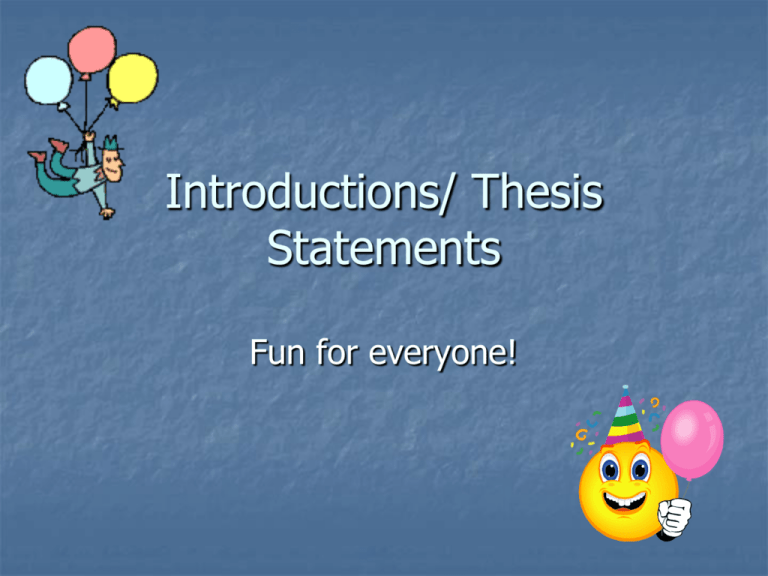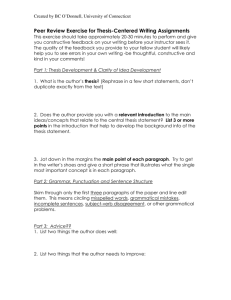soph honors essay structure introductions conclusions
advertisement

Introductions/ Thesis Statements Fun for everyone! Purpose of an Introduction Introduce your topic Capture attention Provide necessary background information Set up your argument/ thesis A Traditional Introduction Attention Grabber/ Interesting Opening Link= Transition between attention grabber and thesis statement. Usually provides background information. Thesis Statement= One sentence summary of your main idea Typical Attention Grabbers Big Picture Historical Context Quote Definition Literary Device (imagery, simile, personification, etc.) Startling fact/ statistic Sample Introduction 1 Heroes are society’s role models, men and women who set the standard high for what life could be like and what people could achieve. Heroes show what is important to a society, betraying the characteristics that a culture values above all others. In the ancient Greek culture, Odysseus was a hero, a man whose legacy transcended generations. By studying the story of Odysseus through Homer’s famous epic poem The Odyssey, the values of the Greek society emerge: courage, power, and determination. However, the values of today’s culture have changed since Greek times. Although Odysseus would have been considered to be a hero in Greek times, he does not deserve the status of a hero today. Sample Introduction 2 The scene is a dark, damp, dreary tomb. Decaying bodies fill the air with an overwhelming stench. It’s here that Romeo comes, desperate to see his wife one more time and join her in death. It’s here that Juliet awakes, only to find her husband dead by her side. It’s here that Juliet hears a noise and quickly ends her own life with a dagger. The two suicides of Romeo and Juliet are expected. The reader has known that they would commit suicide since the prologue of the play. The question is if Shakespeare himself thinks that these two lovers made the right decision. Does he view their suicide as the best ending to their star-crossed love, or does he show the reader the how terrible a self-inflicted death can be? Throughout the whole play, Shakespeare shows us that he does not approve of suicide. Instead, the story of Romeo and Juliet condemns suicide as an immature, selfish action with disastrous results. Characteristics of a Good Thesis FIO!!! F=Focused I=Insightful O=Opinion Thesis Statement Formula In The Scarlet Letter, Nathaniel Hawthorne uses _____________to convey the theme of ___________________. Hawthorne establishes a theme of _____________ by using ____________________. It’s a Contract! You MUST prove what your thesis statement says. You MUST. Practice… In The Scarlet Letter, Hawthorne uses symbolism and wilderness imagery to establish the theme of an individual’s conflict with mainstream society. So…organize your ideas according to your thesis statement. Functional organization= Your organization fits your purpose No need to always have five paragraph essays My Organization Introduction Par. 1= Proof that individual’s conflict with society is the theme. (No mention of lit. techniques yet). Par. 2= Symbolism of the scarlet letter Par. 3= Symbolism of the rose Par. 4= Wilderness Imagery Par. 5= Hester’s new view because of wilderness Conclusion Tips No paragraph should be more than ¾ of a page Each paragraph should be focused on one idea A big concept (such as wilderness imagery) could be broken into more than one paragraph if each paragraph has a slightly different focus Purpose of a Conclusion To synthesize your ideas To emphasize the significance of your topic To wrap up loose ends To create a sense of closure To impress your reader one last time To answer: “So what” So What? A good conclusion synthesizes by answering the question, “so what?” Why should I care? What are the practical applications of your topic? What are the next steps? What’s the big picture? What if? Conclusion Techniques Framing- Relate your conclusion back to your introduction. Anaphora- Repeating the beginnings of sentences. Using the pronoun “we” Using an opening device (like a story or literary device) as a closing device. My Conclusion I admire my colleague’s commitment to the curriculum and her desire to provide a rigorous education for all of her students. Her rigor is a part of RtI, particularly Tier I’s emphasis on a quality curriculum for all students. However, when so many of her students are not learning, something needs to change. Perhaps that change needs to be in the hands of a district learning team that adjusts the curriculum. Perhaps my colleague needs to use different teaching strategies or better Tier II interventions. Whatever the case, we can no longer simply hurtle through the curriculum, covering everything and teaching little. We have to ensure our students are learning. No matter how others may criticize RtI, it’s this commitment to student success that makes me appreciate the initiative. We only really teach when our students learn. The End Or is it?




